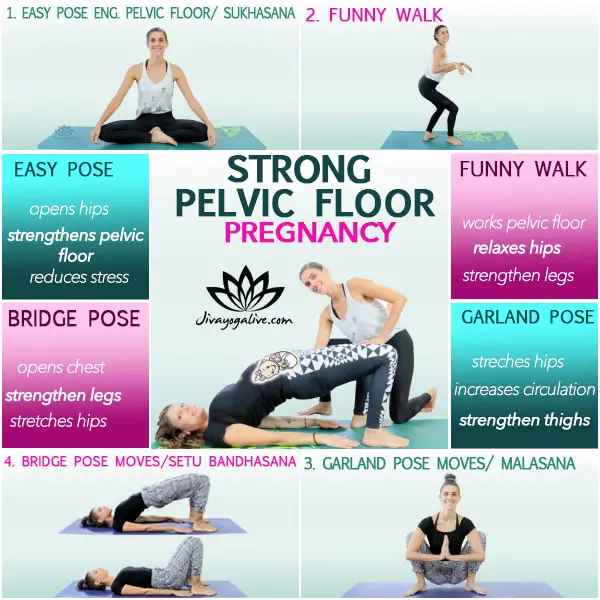Safe Pelvic Floor Exercises During Pregnancy
Exercising your pelvic floor before and during pregnancy should be a top priority for expectant mothers. However, it’s no surprise if you approach the intimate exercise with caution. Firstly, it’s important to know which muscles you should be exercising. If you are unsure on how to locate your pelvic floor muscles, head over to our How To Find Your Pelvic Floor Muscles page.
Besides being good for you and your baby, working out during pregnancy can leave you feeling more energised. Read on to learn about the different exercises you should be doing throughout the course of your pregnancy.
Pelvic Floor Exercises For Pregnancy: 6 Safe Exercises To Get Rid Of Aches
If youre reading this, chances are youve heard of pelvic floor muscles before. The importance of these muscles on not only your reproductive but overall health too can not be overstated. Sure, as a general rule, everyone should consistently work on their pelvic floor muscles. However, the stakes are higher for expectant women.
There are several health benefits of having strong pelvic muscles by pregnant women. And next we take a look at some of the role of these muscles during pregnancy and how to strengthen them.
Will They Get Stronger By Themselves
No. Youll need to help your pelvic floor muscles get strong again. If you dont strengthen the muscles after each baby, youre likely to wet yourself more often when you reach middle age. Pelvic floor muscles tend to weaken with age. Menopause can make incontinence worse.
How can I prevent this happening to me?
- Always squeeze and hold your pelvic floor muscles before you sneeze, cough or lift.
- Dont go to the toilet ‘just in case’ this trains your bladder to want to empty more often.
- Empty your bladder completely when you go to the toilet.
- Avoid constipation by drinking plenty of fluids and fibre-rich foods.
- Dont lift heavy loads too often.
- Dont do bouncing exercises.
- When sitting on the toilet, lean forward. Your knees should be slightly higher than your hips . Rest your elbows on your knees or thighs so that your back is straight. This helps to relax your pelvic floor and sphincter muscles. Gently bulge your abdomen. Relax your pelvic floor and avoid pushing.
To keep these muscles working well, make pelvic floor exercises part of your routine for the rest of your life. You can start during pregnancy and continue after birth. Pelvic floor exercises can be done anywhere while sitting, standing or lying down.
Recommended Reading: What Is The Fastest Way To Lose Weight After Pregnancy
How Long Does It Take To Strengthen The Pelvic Floor
With targeted exercises, consistency, and patience, you may notice an improvement in the integrity of your pelvic floor in as little as 4 weeks. For some, it may take longer up to 3 months to see a major change.
Simple exercises can be done anywhere and involve tightening the muscles of the pelvic floor, as if you are stopping the flow of urination, and holding for a count of 10. Relax the muscles completely before starting another repetition.
The Pelvic Floor After Giving Birth

Things change again after giving birth, and it can be a good idea to talk to an expert about what you should be doing to help your pelvic floor recover and regain strength.
In the first six weeks the pelvic floor focus is on recovery. Research indicates the benefit of strengthening from 6 weeks, especially if there has been any perineal trauma.
Also Check: Can You Lose Weight While Pregnant
Is Exercise Safe For Everyone
Every pregnant woman should consult with her healthcare provider before beginning an exercise program. Your healthcare provider can give you personal exercise guidelines, based on your medical history.
If you have a medical problem, such as asthma, heart or lung disease, or high blood pressure, exercise might not be advisable for you. Exercise might also be harmful if you have an obstetric condition such as:
- Vaginal bleeding or spotting
- Previous premature births or history of early labor
How Does Pregnancy Impact The Pelvic Floor
During pregnancy, the pelvic floor muscles must work harder to support the weight of a baby. This makes it even more important to strengthen your muscles before getting pregnant.
The urinary incontinence that many women experience is related to a weak pelvic floor. The muscles you engage during pelvic floor exercises are essential for pushing your baby out during a vaginal birth.
Read Also: Is Laser Hair Removal Safe During Pregnancy
Why Pelvic Floor Exercises Are Important
During your pregnancy, your pelvic floor muscles will loosen due to hormonal changes in your body. This loosening, along with your growing baby pressing on your bladder, may cause you to leak urine when you cough, laugh, sneeze or exercise.
Doing pelvic floor exercises will strengthen these muscles and help you control any accidents. It will also help you ease your baby out during labour, and recover faster after the birth.
Benefits Of A Strong Pelvic Floor
Strengthening your pelvic floor muscles now ensures that they can properly support a full-term baby and helps your recovery after you deliver your baby. Strong pelvic floor muscles are also associated with a lower risk of injury during a vaginal birth.
A strong pelvic floor means that youre less likely to have urinary or fecal incontinence or experience organ prolapse. If you have pain in your groin or lower back, strengthening the pelvic floor will help minimize your discomfort.
Read Also: What Can Stress Cause During Pregnancy
What Should An Exercise Program Include
For total fitness, an exercise program should strengthen and condition your muscles.
Always begin by warming up for 5 minutes and stretching for 5 minutes. Include at least 15 minutes of cardiovascular activity. Measure your heart rate at times of peak activity. Your heart rate might range from 140 to 160 beats per minute during activity. Follow aerobic activity with 5 to 10 minutes of gradually slower exercise that ends with gentle stretching.
How Do I Perform These Exercises
Learning how to do Kegel exercises can be difficult for some. Unlike other strengthening exercises where you distinctly see and feel the muscle being worked.
It takes some practice to perform Kegels correctly. But once you know what the movement feels like, aim to perform Kegel exercises daily.
I want you to breathe deeply and relax your body when you are doing these exercises.
Make sure you are not tightening your stomach, thigh, buttock, or chest muscles.
Some exercises place more stress on the pelvic floor than others.
So, it’s important you learn what to do, and what not to do.
Discuss any concerns with your doctor prior or women’s health physiotherapist to commencing exercise. This ensures that all exercises and activities are appropriate for you.
When you perform pelvic floor exercises you must use the correct technique to ensure maximum benefit. In my classes, as well as in my online program, I will show you how to effectively activate your pelvic floor muscles.
I will also provide you with pelvic floor routines that consist of short and long holds. I show when you are activating pelvic floors incorrectly. The key is to learn how to ‘let go’ and disengage your pelvic floor. Watch this instructional video below on pelvic floor.
Also Check: What To Know About Pregnancy First Trimester
Why Should I Exercise My Pelvic Floor
The benefits of a healthy pelvic floor are numerous. Exercising these muscles before falling pregnant and during pregnancy can decrease the damage done to the muscles by the strain of carrying a growing baby, decrease the risk of injury during a vaginal birth and speed up recovery afterwards. A strong pelvic floor can also make sex more enjoyable.
And if you dont pay your pelvic floor some attention?
So, if youre planning to hit the gym or run around the backyard with the kids, or if youre prone to the occasional sneeze, pelvic floor strength is going to be your friend.
Tuesday 21 November 2017

Squeezes, Kegels, zip-ups whatever you call them, pelvic floor exercises are important for women at all stages of life.
Pregnancy and birth can put stress on and damage the pelvic floor. So, if you are planning to have a baby, youre pregnant or youve had a baby , now is an especially important time to pay attention to those muscles downtown.
We spoke with Womens Health Physiotherapist Marian Donnelly and the pelvic floor team from the RBWH Womens Health Physiotherapy Department about what you should be paying attention to when you think pelvic floor.
Also Check: Is It Common To Cramp In Early Pregnancy
How Can I Stay Fit
Regular exercise during pregnancy can improve your posture and decrease some common discomforts such as backaches, constipation, bloating, swelling, and fatigue. Exercise can also increase mood and assist with sleep. Being fit during pregnancy means safe, mild to moderate exercise at least 3 times a week, unless you have been otherwise advised by your physician.
If you were physically active before your pregnancy, you should be able to continue your activity in moderation. Dont try to exercise at your former level. Instead, do whats most comfortable for you now. Stay within 70 percent of your target heart rate .
If you have never exercised regularly before, you can safely begin an exercise program during pregnancy after consulting with your healthcare provider. If you did not exercise 3 times a week before getting pregnant, do not try a new, strenuous activity. Start with a low-intensity activity and gradually move to a higher activity level.
How To Strengthen The Pelvic Floor Before Pregnancy
You plan to try to get pregnant soon, and you want to start preparing your body for pregnancy. This is a smart decision, as a study published in The Lancet medical journal reports that getting healthier pre-pregnancy is one of the most effective things you can do to increase your chances of having a successful pregnancy with minimal complications.
Preparing your body for pregnancy involves strengthening your pelvic floor. Heres what you need to know about strengthening the pelvic floor before you try to get pregnant.
Recommended Reading: What Can You Take For Pain During Pregnancy
Thee Best Exercise To Strengthen Pelvic Muscles
Neutral to imprint exercise, is thee best exercise for strengthening pelvic floor muscles.
Its a simple, subtle and such an effective exercise, at drawing in, strengthening, and sustaining strong pelvic floor muscles.
The best explanation of this exercise and really helped me realise its importance for future advanced exercises, came from a yoga teacher and my first teacher training teacher of over twenty years teaching experience, Colette Forrest-Bosque, who has her own fabulous studio here .
Id literally heard the instruction so many times by a variety of teachers, before the penny finally dropped. Aha, thats what they meant.
Is that it!
Life is simple, but we insist on making it complicated. Confucius
Once you get this simple exercise, it will change the way you do further pelvic floor exercises. Its the foundations of future core workout.
What I love about this exercise is you can do it anywhere, sitting, standing, lying.
I loved doing it on my birthing ball when pregnant, as it really helped me be more aware of the muscles I was engaging and strengthening ready for giving birth.
Using a ball really supports and disperses the weight more evenly and helps release the hips at the same time.
All time, must have winner for me in pregnancy.
What Exercises To Avoid During Pregnancy
First off, dont lie on your back for long periods. This is especially true if your pregnancy is over 16 weeks along. Thats because the weight from your bump can press on your main blood vessels. This brings back blood to your heart, resulting in faintness.
Stay away from contact sports like boxing. We dont want you risking getting hit, now do we?
Avoid exercising at heights above 2500m above sea level. Doing this puts you and your baby at risk of altitude sickness.
Avoid doing situps. Intense core exercises like situps will only do more harm than good to your pelvic muscles. So, in the case of pelvic floor exercises and situps for pregnancy, always go for the former.
BetterMe is your fast-track ticket to a long-lasting weight loss! Tailor your fitness journey and maximize your results with just a couple of swipes!
Read Also: Is It Easy To Get Pregnant On Birth Control
What Are Kegel Exercises
Kegel exercises are an effective, relatively easy way to find and strengthen the pelvic floor muscles, which support the bladder, rectum, and uterus. By improving pelvic floor muscle tone, you can help prevent and treat several common pelvic floor disorders, such as urinary incontinence , fecal incontinence, and pelvic organ prolapse , which may occur due to pregnancy and childbirth.
Why Pelvic Floor Health Is Important To Your Pregnancy
Most women dont think about their pelvic floor until after theyve had a baby or two and are having trouble with urine leaking. But waiting until after your baby is born isnt the right time to start thinking about the health of your pelvic floor.
At Kelly Morales OB/GYN, were committed to helping women have the best pregnancies and healthiest babies possible. Dr. Morales and our entire care team understand that a healthy baby starts with a healthy mom. We offer comprehensive pregnancy services to women in and around San Antonio, Texas.
We help you prepare for a healthy pregnancy, delivery, and recovery at home as you care for your baby. Our team has put together this information on pelvic floor health and why its imperative for the health of you and your baby.
Also Check: How To Read First Response Digital Pregnancy Test
Safety Tips For Exercising While Pregnant:
- After your first trimester, avoid exercising while lying flat on your back.
- This position causes the uterus to put pressure on a major vein called the inferior vena cava, which pumps blood back to your heart. Impeding this blood flow can make you dizzy, short of breath or nauseated.
How Soon Can I Exercise After Delivery

It is best to ask your healthcare provider how soon you can begin your exercise routine after delivering your baby.
Although you might be eager to get in shape quickly, return to your pre-pregnancy fitness routines gradually. Follow your healthcare providers exercise recommendations.
Most women can safely perform a low-impact activity 1 to 2 weeks after a vaginal birth . Do about half of your normal floor exercises and dont try to overdo it. Wait until about 6 weeks after birth before running or participating in other high-impact activities.
Also Check: What Happens If You Get Pregnant On Nexplanon
What Happens To The Pelvic Floor During Pregnancy And Birth
Pelvic floor muscles work harder than normal during pregnancy: they are required to support the weight of the growing baby. They are also softened by the effects of pregnancy hormones.
Whether your give birth vaginally or by caesarean, youre pelvic floor muscles will be impacted.
During a vaginal birth, the pelvic floor muscles undergo considerable stretching and strain. During a caesarean, surgery through multiple muscle layers can lead to a slower recovery generally and a weakened abdominal wall.
While pregnant, women can still exercise their pelvic floor, but might need to change their routine. Marian recommends talking to a physiotherapist about your pelvic floor during pregnancy.
During pregnancy, pelvic floor exercises become more difficult. A pelvic floor physiotherapist can modify an individual program of safe pelvic floor exercises as the pregnancy progresses.
Let’s Chat About Overactive Pelvic Floor
Note of Caution
Avoid doing Kegel exercises at the same time you are urinating. Doing the exercises while you are urinating can weaken your pelvic floor muscles over time. Or cause damage to bladder and kidneys.
Doing Kegel exercises incorrectly or with too much force may cause vaginal muscles to tighten too much. This can cause pain during sexual intercourse.
What if I experience pain?
You are likely not performing your Kegels correctly if you feel pain in your abdomen .
As you contract your pelvic floor muscles, the muscles in your abdomen, back, buttocks, and sides should remain loose. Please seek professional help when needed.
Recommended Reading: How Can We Know About Pregnancy
Exercises For A Fitter Pregnancy
If you are pregnant, try to fit the exercises listed in this section into your daily routine. These types of exercise will strengthen your muscles to help you carry the extra weight of pregnancy. They’ll also make your joints stronger, improve circulation, ease backache, and generally help you feel well.
Natural Ways To Strengthen Your Pelvic Floor During Pregnancy
Pregnancy brings unprecedented changes as well as developments in a womans body and some complications also take place. A section of pregnant women face hassles like frequent urination and incontinence, apart from various developments caused by hormonal changes. It is important to tone and strengthen the pelvic floor muscles in pregnancy.
The pelvic floor has functions like:
- Supporting your bladder, uterus and bladder
- Giving you control over bowel and bladder
- Stabilizinghip and lower back joints
- Providing base for vaginal functioning
Being pregnant an actually exert stress on the pelvic floor muscles. The pelvic floor region may get weakened and stretched after the first trimester. Constipation which affects pregnant women often can also strain the pelvic floor.
Read More:11 Home Remedies to Stop Pelvic Pain during Pregnancy
Recommended Reading: What Is The Likelihood Of Getting Pregnant On Nexplanon

